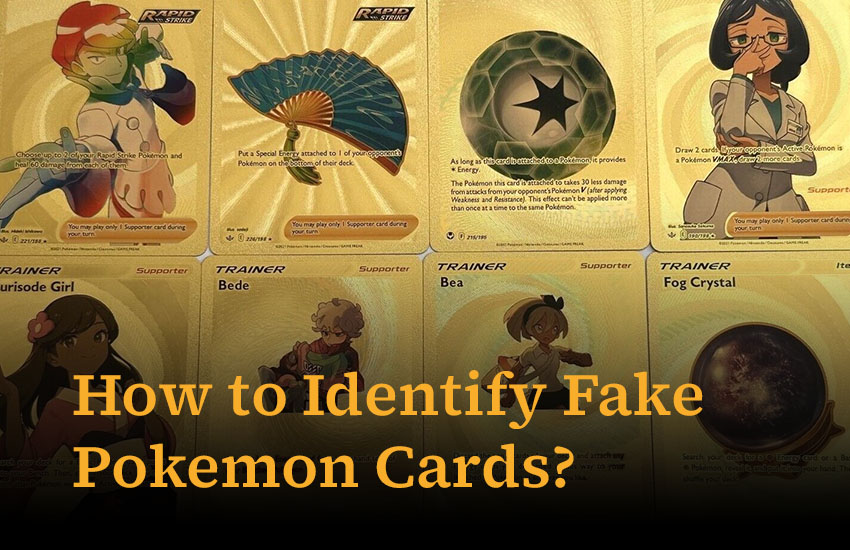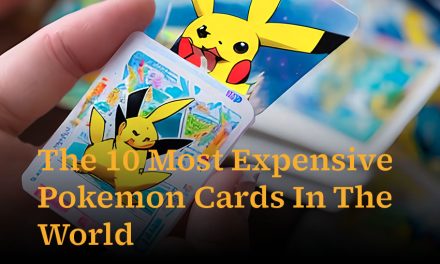Many people love to collect Pokémon cards, but unfortunately, there are many scammers who try to sell fake Pokémon cards. Here I’ll tell you how to spot fake Japanese Pokémon cards, so you don’t get ripped off!
For the past 20 years, Pokémon cards have been selling in the market like hotcakes. Now it doesn’t seem their demand will decrease anytime soon.
Printing and selling fake Pokemon cards is against the Pokémon’s company trademark. Scammers through websites including eBay, Amazon, TCGplayer, and direct selling trick fans out of their money. In January 2023, Chinese customs officials seized approximately 20 boxes of fake Pokémon cards weighing 7.6 tons.
If you suspect a card is fake, fear not, I’ll share all methods that experts use in the authentication center. After going through this article, you’ll get to know how to identify fake Pokémon cards. Scroll down to read!
How to Tell Fake and Real Pokémon Cards? 4 Common Tests
Sometimes you’ll come across a card that will simply feel like a fake one. Trust your gut. Your sixth sense can identify patterns and differences before your conscious brain does. If you spend more time with real Pokémon cards, you can identify them easily.
Whenever you suspect a card is fake, it’s the right time to pass the card through some tests. But remember, no test is 100% trustable.
Under one or two tests, some cards may look like real ones. Also, some original Pokémon cards may appear fake.
That’s why I advise you to not rely on a single test. Here, I’m going to share some tests that you can perform to identify fake Pokémon cards.

Test 1: Carefully Read the Card
First of all, go through all the text written on the card. Check for any grammar, spelling and printing mistakes. If you find any such mistakes, it is likely that the card is fake.
The following errors indicate Pokémon card is fake.
- Spelling errors
- Grammatical errors
- The word “Pokémon” without an accent over e.
- Any other words like “Pocket Monster.” instead of the word “Pokémon”
- HP or Attack values equal to or >1000 (Pokémon card’s HP not higher than 340.)
- Difficulty of Test
This test has low difficulty and is one of the easiest tests to perform.
- Reliability of Test
You can’t fully rely on this test. Fake Pokémon cards have the same text as real cards, so there are no clear mistakes. Some old Pokémon cards have few printing or spelling mistakes, however, the exceptions are addressed here and you can check them.
Test 2: Compare the Card Back
Most people ask how to spot fake Vmax Pokémon cards, you need to note one thing: fake Pokémon cards like EX, VMAX, and GX are reflective and when compared their backs with real cards, they look washed out.
Comparing cards back is an authentic test to identify fake Pokémon cards. There is a lot of difference between fake and real cards. If original, their backs will be identical.
Here are some main red flags about fake cards:
- There is bleeding between the card’s blue border and the rest of the blue in its design. Real Pokémon cards have distinct borders, not like other blue in its design
- They’ve almost washed out colours
- Difficulty of test
The difficulty of this test is medium unless you’re quite familiar with Pokémon cards. If you’re a beginner, you’ll need an authentic card for comparison. If you’re buying cards through online platforms, this test will not be helpful.
- Reliability of test
This is the most reliable test if you want to differentiate between real and fake cards. Our experts use this test to verify cards for TCGplayer Direct. Every Pokémon card has an identical back no matter when it was created.
Test 3: Comparing the Card to an Online Scan
Do you have a golden Pokémon card but don’t know how to spot a fake golden Pokémon card? Here is what you need to do!
Get a card image through a legit Pokémon TCG database such as the official Trading Card Database or pkmncards.com. Then, compare the card to that picture and note the differences
- False HP value.
- Incorrect font or font size
- Incorrect attack damage values on the card
- Different energy symbols with variations in their size
- Wrong set symbol or number.
- Difficulty
The difficulty of the test is medium. All you need is to have an internet connection. You should be familiar with Pokémon, so you can find the required card online.
- Reliability
This test is not 100% reliable as many legit Pokémon cards have different versions. Also, online databases don’t have complete information about all cards except for pkmncards.com.
Test 4: Compare the Card to a Real Pokémon Card
If you have a real card, compare the suspicious card with it. There may be many similarities but they will not be the exact copies. Compare them carefully and look for minor differences. Some of the red flags for fake cards are:
- There will be a significant weight difference
- The cardstock is either too thin or weak
- Flat, untextured foiling when the foiling style should leave a texture.
- Messy and rough edges(The edges of an actual Pokémon card are straight, smooth and clean)
- Difficulty
This test has a high difficulty level. If you’re a complete beginner, it might be challenging for you to spot the minor variations. To become an expert in identifying cards, you need to build your experience by noticing real Pokémon cards first
- Reliability of test
Once you’re able to spot the variations, this test is reliable. If experienced, you can tell their difference quickly.
Tests We Don’t Recommend
There are many other tests that people use to tell if a Pokémon card is fake or real. But we don’t recommend these tests. The reason is simple they give false positive results or they can damage your cards.
1. Bend Test
The general idea of this test is to check the strength of the card by bending whether it becomes smooth when you release pressure.
But remember, it can damage your card, that’s why we don’t recommend this test. Also, we think there is no need to perform this test as your fingers are sensitive enough to check the durability of the Pokémon card without bending.
2. Rip Test
As the name suggests, it refers to ripping a card in half. Real Pokémon cards have two thin cardboard pieces attached together, having a black layer in the middle.
When you rip a card, this middle layer appears, if not found then the card is fake. This test can be reliable to some extent but there is a risk that you’ll damage your card that could be worth many hundred or thousand pennies.
3. Light Test
This test helps you check the quality and thickness of Pokemon cards. You simply need to place the card in front of the light to see how much light is passed or reflected. If a significant amount of light passes through the card, it indicates the card is most likely fake.
But don’t rely on this test as there are many variations in real Pokémon cards. Since 1999, two different companies have been involved in Pokemon card printing and using different foiling techniques. This variation in foiling gives different results to light. Also, there are some environmental variations that affect the result.
To spot fake gold Pokemon cards or VMAX cards, somehow this test can be helpful. But it’s not reliable as it generates many false positive results, so we don’t recommend it.
Tips on How to Spot Fake Japanese Pokémon Cards
- At the bottom left corner, the illustrator’s name is written in Real Pokémon cards. If you don’t find any such name, the card is fake.
- Before assuming it as a fake card, make sure to check it thoroughly.
- Whenever you buy a fake Pokémon card or booster, return it. If you can’t do this, immediately get rid of it, so it can’t be used to scam other people.
- Always buy cards from a trusted dealer.
Final Words
Counterfeit Pokémon cards are widespread, but yet easy to spot. If you’re able to spot the difference between a Bidoof and a Beedrill, then you’re already familiar with what is needed to spot fake Pokémon cards.
In short, the more time you spend with real Pokémon cards, the more sensitive your perception will become. After going through this article on how to identify fake Pokémon cards, no matter if you’re a beginner, you can easily tell whether a card is fake or real.
FAQs
1. How to tell fake Pokémon cards gold?
You can identify a fake gold Pokémon card by checking it through a digital scan. Check out the spelling errors, a symbol on the letter ‘e’, card foil, colour, HP value, and borders.
2. How to spot fake Vmax Pokémon cards?
Fake V/VMAX Pokémon cards have a highly reflective shiny and glossy look, helping hide any printing errors. Also, when you compare them with a real card, they appear washed out.
3. Do fake Pokémon cards have a shiny texture?
Notice the card’s texture of card, if authentic, it will have a smooth texture. Fake Pokémon cards tend to have a shiny and glossy texture because they help hide printing errors.





